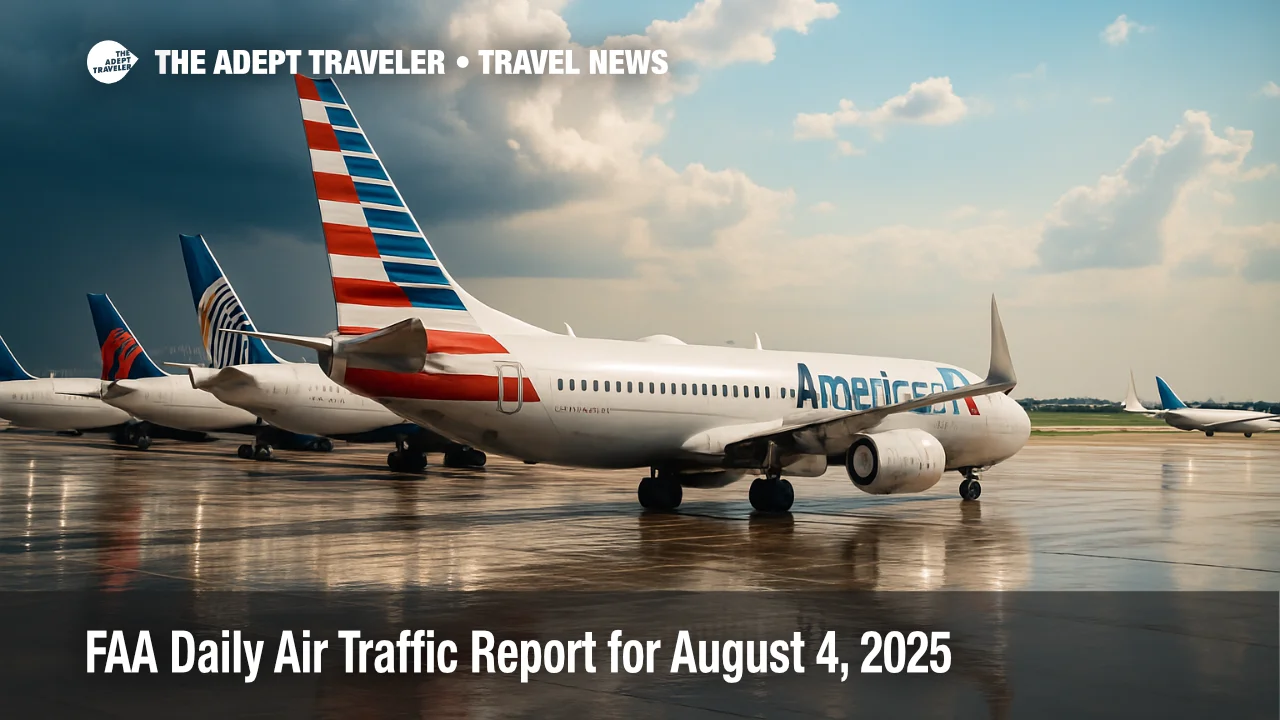FAA Daily Air Traffic Report Flags Wide U.S. Delays

Thunderstorms sweeping the Gulf and Atlantic coasts, plus high winds and Canadian-fire smoke elsewhere, set the stage for a bumpy Monday in U.S. airspace. The Federal Aviation Administration's Daily Air Traffic Report for August 4 warns of delays at more than a dozen major airports, from Fort Lauderdale-Hollywood International Airport (FLL) to San Francisco International Airport (SFO). Travelers with tight connections should build buffer time and watch for rolling ground stops later today. Flight delays, ground stops, and refund rights matter even when weather is to blame.
Key Points
- Why it matters: Multiple hub airports face compounding weather delays.
- Travel impact: Afternoon ground stops could strand passengers for hours.
- What's next: ATCSCC webinar at 09 15 EDT will update mitigation plans.
- Advisories: Dallas/Fort Worth GDP already limits American Airlines arrivals.
- Heads-up: Boston smoke may trigger evening arrival holds.
Snapshot
The FAA lists thunderstorms for Fort Lauderdale (FLL), Miami (MIA), Orlando (MCO), Palm Beach (PBI), Tampa (TPA), Dallas Love Field (DAL), Dallas/Fort Worth (DFW), William P. Hobby (HOU), and George Bush Intercontinental (IAH). High winds threaten Harry Reid International Airport (LAS) and SFO, while low clouds cover San Diego International Airport (SAN). Wildfire smoke from Canada could slow Logan International Airport (BOS). Monday's earlier [FAA ground stop risk update] from Adept Traveler outlines similar trouble spots, underscoring how quickly morning forecasts turn into afternoon flight delays.
Background
The FAA Daily Air Traffic Report summarizes weather, runway closures, and other constraints expected to disrupt the National Airspace System during the next 24 hours. Compiled by the Air Traffic Control System Command Center (ATCSCC), the brief guides airlines and airports as they schedule slot-controlled arrivals, file alternate routes, or activate ground delay programs. Because the document publishes before 08 00 EDT, conditions often worsen-or improve-by mid-day. Travelers who rely on the report should monitor both the real-time NAS Status site and airline push alerts to catch last-minute changes.
Latest Developments
Storms and Smoke Trigger Delay Programs
ATCSCC Advisory 030 confirms a ground delay program at DFW for American Airlines and its subsidiaries through 14 59 Z. The same memo keeps ATL in the en-route plan, anticipating southern storms, and highlights smoke over BOS that could evolve into a late-day ground stop. Route-structure caps already affect Florida Panhandle traffic, while collaboration-decision triggers monitor airborne counts for additional throttling. Flight delays and ground stops are therefore probable, not merely possible, as weather cells march east.
Florida and Texas Face Afternoon Ground Stops
The advisory warns that Orlando, Tampa, Fort Lauderdale, Miami, and Palm Beach could move from tactical holds to full ground stops after 15 00 Z if thunderstorm coverage expands. Houston's twin airports and Austin-Bergstrom appear on the evening watch list, alongside Boston, Newark, and Washington National. Passengers should prepare contingency plans and revisit airline rebooking pages before leaving for the airport. Ground stops freeze departures at the point of origin, so remote travelers may feel the pain hours before local weather breaks.
Analysis
Storm-season clockwork is turning a routine Monday into a complex puzzle of flight delays, ground stops, and reroutes. The FAA's Daily Air Traffic Report plays a pivotal role by giving carriers early notice, yet the finer detail resides in ATCSCC advisories that update every few hours. Today's sequence shows how a Dallas GDP can cascade outward, first lengthening arrival queues, then forcing airlines to adjust crew and aircraft rotations system-wide. High-volume Florida tourism markets amplify the ripple, especially when multiple airports share the same storm cell track. Wildfire smoke, a growing summer hazard, adds another variable; particulate ceilings reduce visibility and force mile-in-trail spacing that steals airport capacity. Travelers who track these layers-especially those booked through connecting hubs-can exploit rebooking windows before seat inventories vanish. Most carriers allow no-fee same-day changes during weather events, and Department of Transportation rules guarantee refunds when flights are canceled outright. In short, the best defense against weather-driven flight delays is advance intelligence and swift action.
Final Thoughts
As thunderstorms, high winds, and smoke converge, the August 4 FAA Daily Air Traffic Report reminds travelers that situational awareness is key. Consult official FAA sources, monitor airline alerts, and act quickly when ground stops loom. Doing so can turn a day of potential chaos into a manageable inconvenience-and ensure you stay ahead of the next FAA Daily Air Traffic Report.
